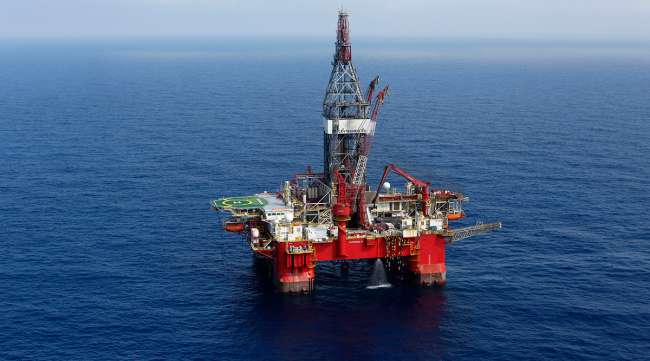Associated Press
$264 Million Offered for Gulf Oil Under Climate Compromise

[Stay on top of transportation news: Get TTNews in your inbox.]
NEW ORLEANS — Oil companies offered a combined $264 million for drilling rights in the Gulf of Mexico on March 29 in a sale mandated by last year’s climate bill compromise.
The auction was the first in the Gulf in more than a year and drew interest from industry giants including ExxonMobil, Shell and Chevron. It could further test the loyalty of environmentalists and young voters who backed President Joe Biden in 2020 but were frustrated by this month’s approval of the huge Willow drilling project in northern Alaska.
Developing the leases for sale in public waters in the Gulf of Mexico could produce more than 1 billion barrels of oil and more than 4 trillion cubic feet of natural gas over 50 years, according to a government analysis. Burning that oil would increase planet-warming carbon dioxide emissions by tens of millions of tons, the analysis found.
Oil prices fell sharply over the past year and it was uncertain how much companies would be willing to invest in new leases. There’s one more sale scheduled in September, but it’s unknown how many more the administration could conduct, which could hinder companies’ expansion plans.
Yet analyst Sami Yahya said approval of the ConocoPhillips Willow project in the National Petroleum Reserve-Alaska bodes well for the industry and prospects for future leasing.
“It showed that the Biden administration is likely trying to strike a balance between energy transition and energy security,” said Yahya with S&P Global.
The Department of Interior sale comes two days before a deadline set in last year’s climate bill that Biden signed into law. The measure prohibited leasing public lands for renewable power unless tens of millions of acres are first offered for fossil fuels. That was a concession to get support from West Virginia Democrat Joe Manchin, a fossil fuels industry supporter.
The undersea parcels that were up for auction covered 114,000 square miles, an area larger than Arizona. Like past auctions of similar magnitude, only a fraction of the available acreage — about 2,600 square miles — got bids. The vast majority of the 313 tracts that received offers had only one bidder.
The sale took place in a state that is economically dependent on the oil and gas industry but also especially vulnerable to climate change.
Since it takes years to develop offshore parcels before crude is pumped, the leases could produce oil and gas long past 2030, when scientists say the world needs to have drastically cut greenhouse gas emissions to stave off catastrophic climate change.
Sea level rise is a factor in Louisiana’s steady loss of coastal wetlands, which in addition to harboring a variety of fisheries and wildlife, provide a buffer between inland population areas and hurricanes that scientists say are growing stronger as the world warms.
Louisiana’s complicated relationship with the industry also is illustrated by lawsuits filed by coastal parishes over decades of alleged damage to wetlands from dredging canals to service oil and gas drilling.
ExxonMobil offered the high bids on 69 tracts in the northwest Gulf. The company in 2021 bid nearly $15 million for tracts in the same region, which includes shallow waters — less than 656 feet deep — where oil has mostly played out and there are few active leases.
Analysts say the acquisitions appear linked to Exxon's pursuit of a government-industry collaboration to capture and store carbon dioxide from industrial plants in the Houston Ship Channel. The carbon dioxide would be carried away in pipelines and injected deep under the floor of the Gulf of Mexico, a process known as carbon capture and sequestration, or CCS.
ExxonMobil spokesperson Todd Spitler declined to say if there was a link between its bids and the carbon capture proposal.
“We will work with the Department of Interior on plans for the blocks once they are awarded,” he said. “ExxonMobil takes a long-term business view, and we will evaluate the seismic and subsurface geology for future commercial potential.”
Before the final bidding results were announced, representatives from the American Petroleum Institute and National Ocean Industries Alliance already were calling for more lease sales to be scheduled, so companies can start exploration work and ensure supplies of oil in the future.
Environmentalists again called on Biden to abide by a 2020 campaign pledge to end new drilling and leasing. Diane Hoskins with the group Oceana said the Democrat can “make good on his promise” by including an end to leasing in a long-overdue five-year plan for the Gulf, which Interior Department officials say will be ready by the end of the year.
A lawsuit against the March 29 sale is pending before a U.S. District judge in Louisiana. It takes 90 days for the government to evaluate any bids, which means they still could be blocked before being issued.
“There’s been a lot of talk from the administration about taking climate change seriously and moving our economy away from fossil fuels, and yet we continue to see massive oil and gas projects, both onshore with Willow and offshore in the Gulf of Mexico,” said George Torgun, an attorney with Earthjustice representing environmental groups in the case.
Chevron said in a March 27 court filing that it could lose millions of dollars from future production if the leases are blocked. The company’s Gulf of Mexico operations produce the equivalent of almost 200,000 barrels a day from hundreds of leases it has bought since 2001, a representative of the Houston-based company said in an affidavit.

Joel Morrow of Alpha Drivers Testing & Consulting traveled across America asking one simple question: What if a trucker designed a truck? Hear the program above and at RoadSigns.TTNews.com.
“Chevron plans to produce from its Gulf of Mexico leases for decades into the future,” said Trent Webre, a Chevron manager in the region.
At the prior Gulf of Mexico auction in 2021, companies offered a combined $192 million for tracts totaling nearly 2,700 square miles. That sale was subsequently blocked by a federal judge, then reinstated under last year’s climate bill.
Over several months beginning in May the administration plans to auction more than 500 square miles of onshore oil and gas leases in Wyoming, New Mexico, Montana, Nevada and other states.
Brown reported from Billings, Mont.
Want more news? Listen to today's daily briefing below or go here for more info:




